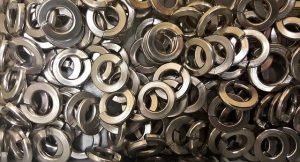
Consisting of a disc-shaped piece of material with a hole in the middle, washers are often used with bolts. They are typically used to distribute a bolt’s load more evenly to protect the joined workpiece from damage. Prior to driving a bolt into a workpiece, a washer is placed at the top of the bolt’s shaft where it meets the head. The washer will then absorb the compression forces of the bolt as it’s driven into the workpiece.
There are many different types of washers, however. Some washers are classified as flat, whereas others are classified as lock washers. What’s the difference between flat and lock washers exactly?
What Is a Flat Washer?
The most common type of washer is a flat washer. They receive their namesake from flat design. Flat washers aren’t curved, nor do they protrude. Rather, they are completely flat on both sides. This flat design makes them highly effective at distributing loads.
Without a washer, the compressive forces of a bolt will be applied to the underside of the bolt’s head. A flat washer absorbs these compressive forces while subsequently distributing them more evenly.
Common materials in which flat washers are made include the following:
- Stainless steel
- High-carbon steel
- Brass
- Copper
What Is a Lock Washer?
Also known as a split washer, a lock washer is a special type of washer that’s designed to create tension so that the bolt doesn’t loosen or otherwise come out of its installed position. Lock washers aren’t flat. They feature a semi-coiled design that gradually rises. This design allows lock washers to create tension when installed.
Lock washers work by preventing the rotational movement of the installed bolt. Nuts are often used for this purpose as well. When placed on the end of a bolt, a nut can protect it from loosening. The problem with nuts is that they are susceptible to vibrations. When exposed to vibrations, a nut may loosen. If a nut loosens too much, it may fail to secure the bolt in the workpiece’s threaded hole. With a lock washer, however, the bolt won’t come out. A lock washer will “lock” the bolt in the workpiece’s threaded hole.
In Conclusion
Flat and lock washers are two of the most common types of washers. A flat washer is a basic washer that’s flat on both sides. A lock washer is a semi-coiled washer that’s used to secure bolts in place.
